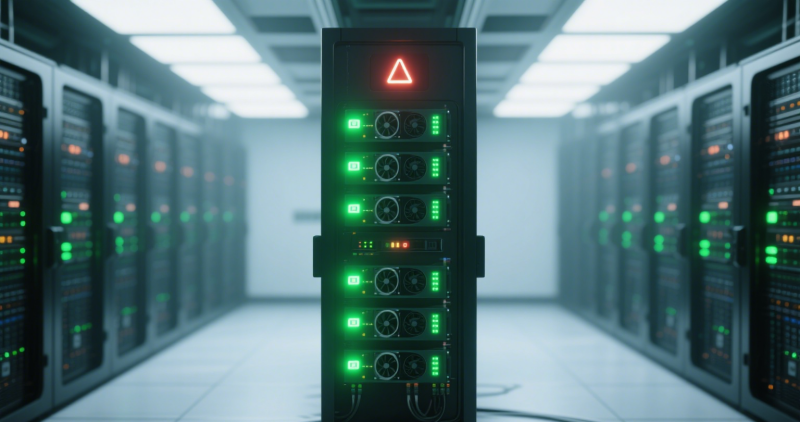Imagine this: Your mission-critical large language model training job has been running for 47 grueling hours on a cluster of powerful NVIDIA H100 GPUs. You’re on the home stretch, just one hour away from completion and validation. Suddenly, the entire job crashes. Diagnosis? An overheated H100 node silently failed, corrupting days of computation. The cost isn’t just the wasted electricity; it’s the lost GPU hours (burning thousands of dollars), the missed project deadline, the frustrated data science team scrambling to restart, and the delayed product launch. This scenario isn’t science fiction; it’s a painful reality for AI teams relying on complex GPU infrastructure without real-time visibility. Reactive monitoring – checking logs after the fire alarm sounds – is simply too late for AI at scale. The stakes are too high.
Why Real-Time Alerts Are Non-Negotiable for AI Scale
Traditional monitoring tools often fall short for modern AI workloads on high-performance GPU clusters like NVIDIA H100, H200, A100, or even dense RTX 4090 setups. They typically suffer from:
Lagging Metrics:
Hourly or even 5-minute checks can completely miss critical micro-failures or rapid performance degradation. A thermal spike that throttles your H100s for 3 minutes might not show up in an hourly average, but it can derail a sensitive distributed training step.
Siloed Data:
Knowing a GPU reported high temperature separately from seeing a CUDA kernel crash or NVLink errors creates a fragmented picture. Correlating hardware health with application failures is left to manual detective work.
The unique demands of AI workloads create specific risks that demand instant notification:
- Thermal Throttling & Failure: Densely packed H100, H200, or A100 nodes generate immense heat. Real-time temperature and power draw monitoring is crucial to prevent throttling (slowing down your expensive compute) or catastrophic node failure.
- NVLink/Network Saturation: Distributed training across multiple GPUs relies heavily on ultra-fast interconnects like NVLink and high-bandwidth networking. Saturation or errors here cause cascading stalls, crippling training efficiency. You need alerts the moment bandwidth drops or errors spike.
- GPU Memory Leaks & OOM Crashes: Inference endpoints serving LLMs can be particularly vulnerable. A slow memory leak or unexpected spike in request load can lead to Out-of-Memory (OOM) crashes, taking critical services offline instantly. Real-time VRAM monitoring is essential.
Waiting to discover these issues after they cause job failures or service outages is no longer acceptable. Prevention requires proactive, instant awareness.
WhaleFlux: Real-Time Alerting Built for AI Hardware
Catching a failing GPU just 5 minutes sooner can save thousands in lost compute time and prevent project delays. WhaleFlux, the intelligent GPU resource management platform designed specifically for AI enterprises, makes this level of proactive monitoring automatic. It goes beyond basic uptime checks to provide deep, real-time insights into the health and performance of your valuable GPU assets – whether they are H100s, H200s, A100s, or RTX 4090s.
WhaleFlux delivers critical real-time alerting capabilities:
Hardware-Level Triggers:
- Immediate alerts on abnormal temperatures or power draw, configured with GPU-specific thresholds (H100s have different tolerances than A100s or RTX 4090s).
- Detection of NVLink bandwidth degradation or error rate spikes, preventing distributed training stalls.
Resource Exhaustion Warnings:
- Real-time alerts on sudden GPU memory or utilization spikes during training runs, signaling potential instability.
- Proactive low VRAM warnings on inference nodes, allowing intervention before an OOM crash takes down your API.
Cluster-Wide Anomaly Detection:
- Intelligent auto-correlation: WhaleFlux doesn’t just alert on a single hot RTX 4090; it can detect and alert that this node’s overheating is impacting the performance of adjacent A100s in the same rack.
Cost Guardians:
- Notifications on idle reserved GPUs (owned or leased), prompting immediate reallocation or shutdown to stop burning budget.
- Budget burn alerts: Get notified if your cluster spend suddenly exceeds forecast (e.g., “Cluster spend exceeded forecast by 15% this week”), allowing rapid cost control.
WhaleFlux transforms your GPU cluster from a potential liability into a resilient, cost-efficient powerhouse.
Real-Time Stock Tracking: Your GPU Inventory, Always Visible
Lost track of which H100s you own versus lease? Need to urgently find available H200 capacity for a new project? Managing a diverse fleet of GPUs (H100, H200, A100, RTX 4090) across multiple clusters, especially when mixing owned hardware with leased resources (remember, WhaleFlux offers flexible purchase and monthly minimum leasing options), can become a logistical nightmare. Lack of visibility leads to costly overbuying or crippling underutilization.
WhaleFlux’s Solution: A centralized, live inventory dashboard.
- See Everything, Instantly: Track all your GPU assets – owned H100s, leased H200s, owned A100s, RTX 4090 dev nodes – across every cluster and cloud environment in one unified view.
- Identify Waste: Instantly visualize the gap between GPU allocation and actual utilization. See which expensive H100s are sitting idle or which A100 clusters are underused.
- Smart Inventory Alerts: WhaleFlux proactively tells you what you need to know:
“Only 2 H100 nodes currently idle – Large 48hr training job queued. Scale up now?”
*”3 leased A100 nodes expiring in 7 days – Renew or release to avoid auto-renewal costs?”*
“RTX 4090 dev cluster utilization below 20% for 7 days – Consider consolidating workloads?”
Business Impact: Eliminate the guesswork and panic. WhaleFlux’s real-time inventory tracking ensures you never overbuy hardware you don’t need or scramble at the last minute because you forgot about expiring leases. It maximizes the value of every GPU dollar spent, whether purchased outright or leased monthly through WhaleFlux.
Implementing Proactive Alerts Without the Noise
The fear of alert fatigue – being bombarded with trivial notifications – often paralyzes teams and prevents them from implementing potentially lifesaving monitoring. WhaleFlux is designed to cut through the noise with intelligent alerting:
- AI-Powered Triage & Dynamic Thresholds: WhaleFlux doesn’t rely solely on static thresholds. It learns the “normal” behavior of your specific GPUs running your specific workloads. Is an RTX 4090 typically hotter under load than an A100? WhaleFlux knows, and adjusts its alerting sensitivity accordingly, reducing false positives.
- Smart Alert Grouping: Instead of 12 separate alerts for 12 RTX 4090s showing a similar memory spike pattern during a specific training phase, WhaleFlux groups them into a single, actionable incident: “RTX 4090 cluster showing correlated memory spikes during phase 3 training.”
- Targeted Escalation Paths: Configure alerts to reach the right people via the right channels. Send critical hardware failure alerts (e.g., H100 overheating) directly to on-call engineers via PagerDuty, while cost warnings (idle GPUs) go to FinOps teams via Slack or MS Teams.
- Zero Overhead Deployment: WhaleFlux integrates seamlessly with your existing infrastructure, deploying on Kubernetes or bare-metal without massive configuration burdens. You get powerful monitoring without adding operational complexity.
WhaleFlux ensures that every alert you receive is meaningful and demands action, turning monitoring from a chore into a strategic advantage.
The Cost of Silence: Real-World ROI
What does ignoring real-time alerts actually cost? Let’s translate WhaleFlux’s capabilities into tangible savings:
Use Case 1: Preventing Node Failure
- Scenario: WhaleFlux detects an abnormal, rapid thermal spike on a critical H100 node during a peak training load.
- WhaleFlux Alert: *”CRITICAL: Node H100-ClusterA-07: Core Temp 102°C (Threshold 95°C) & Rising. Risk of Thermal Shutdown.”*
- Action: The on-call engineer receives the alert via PagerDuty. WhaleFlux can optionally be configured to automatically start draining workloads from the affected node safely. The node is taken offline for inspection before catastrophic failure.
- ROI: Preventing the failure saves the cost of the node repair/replacement (potentially $8k-$10k+ for an H100), avoids the loss of the 47-hour training job (thousands more in wasted compute), and prevents team downtime. WhaleFlux paid for itself in one incident.
Use Case 2: Eliminating Waste from Idle Resources
- Scenario: WhaleFlux’s cost guardian alerts identify a cluster of 8 leased A100 GPUs sitting completely idle for over 2 weeks.
- WhaleFlux Alert: *”COST ALERT: Cluster ‘Inference-Staging’: 8x A100 (Leased) idle for 336 hours. Estimated waste: $15,120/month.”*
- Action: The Cloud Cost team investigates. The cluster was provisioned for a completed project and forgotten. They immediately release the leased A100s back through WhaleFlux (avoiding next month’s rental fee) or reassign them to a new inference workload.
- ROI: Reclaiming $15k+ per month in pure waste. WhaleFlux’s inventory and cost alerts provide constant visibility to stop budget bleed.
Use Case 3: Optimizing Fleets (Including RTX 4090s)
- Scenario: WhaleFlux’s inventory dashboard and alerts show consistently low utilization (<25%) on a pool of RTX 4090s dedicated to researcher prototyping, while a separate A100 cluster for batch inference is frequently overloaded, causing delays.
- WhaleFlux Insight: “Alert: RTX 4090 Dev Pool avg. util. <25% for 14 days.” & *”Alert: A100 Batch-Inference Cluster avg. queue time >2 hours.”*
- Action: The MLOps team uses WhaleFlux to temporarily reassign some RTX 4090s to handle less demanding batch inference tasks during off-peak research hours, alleviating the A100 bottleneck without needing new hardware.
- ROI: Improved inference throughput and researcher satisfaction by better utilizing existing resources (RTX 4090s), delaying the need for expensive A100/H100 expansion. WhaleFlux ensures all GPUs, including cost-effective RTX 4090s, pull their weight.
Conclusion: From Firefighting to Fire Prevention
In the high-stakes world of AI powered by expensive, complex GPU clusters like NVIDIA H100, H200, A100, and RTX 4090, unplanned downtime isn’t just an inconvenience; it’s a direct hit to your bottom line and competitive momentum. Reactive monitoring leaves you constantly firefighting. Real-time, intelligent alerting transforms your infrastructure from fragile to resilient.
WhaleFlux provides the critical edge: It gives you the heartbeat of every GPU in your fleet, owned or leased. Its AI-driven, hardware-aware alerts empower you to act before minor issues escalate into costly outages or budget blowouts. By providing unparalleled visibility into utilization and inventory, WhaleFlux ensures you only pay for the GPU power you genuinely need and use.
Stop reacting to GPU fires. Start preventing them. Transform your GPU management from a cost center into a strategic, optimized engine for AI innovation.
Optimize GPU spend with WhaleFlux’s alert-driven platform. [Schedule a Demo] to see how we manage H100, H200, A100, and RTX 4090 clusters for maximum uptime and efficiency today.

